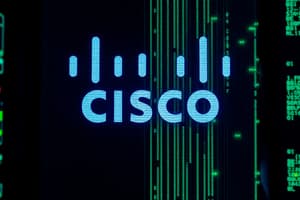Podcast
Questions and Answers
What does CCA stand for?
What does CCA stand for?
Cisco Certified Architect
What does CCIE stand for?
What does CCIE stand for?
Cisco Certified Internetwork Expert
What does CCNP stand for?
What does CCNP stand for?
Cisco Certified Network Professional
What does CCNA stand for?
What does CCNA stand for?
What does CCENT stand for?
What does CCENT stand for?
What does WAN stand for?
What does WAN stand for?
What does IOS stand for?
What does IOS stand for?
What does NAT stand for?
What does NAT stand for?
What does TCP stand for?
What does TCP stand for?
What does UDP stand for?
What does UDP stand for?
What does IP stand for?
What does IP stand for?
What does ICMP stand for?
What does ICMP stand for?
What does ARP stand for?
What does ARP stand for?
What does RARP stand for?
What does RARP stand for?
What does VLSM stand for?
What does VLSM stand for?
What does CIDR stand for?
What does CIDR stand for?
What does FLSM stand for?
What does FLSM stand for?
What does PVC stand for?
What does PVC stand for?
What does SVC stand for?
What does SVC stand for?
What does CSU/DSU stand for?
What does CSU/DSU stand for?
What does TFTP Server stand for?
What does TFTP Server stand for?
What does NVRAM stand for?
What does NVRAM stand for?
What does DCE stand for?
What does DCE stand for?
What does DTE stand for?
What does DTE stand for?
The total number of usable subnetted hosts is calculated by ____.
The total number of usable subnetted hosts is calculated by ____.
The total number of hosts is calculated as the number of all hosts minus ____.
The total number of hosts is calculated as the number of all hosts minus ____.
Flashcards are hidden until you start studying
Study Notes
Cisco Certifications
- CCA: Cisco Certified Architect, highest level of Cisco certification.
- CCIE: Cisco Certified Internetwork Expert, advanced certification focusing on network engineering.
- CCNP: Cisco Certified Network Professional, validates skills in planning, implementing, and troubleshooting networks.
- CCNA: Cisco Certified Network Associate, foundational certification for networking.
- CCENT: Cisco Certified Entry Networking Technician, entry-level certification for basic networking knowledge.
Networking Concepts
- WAN: Wide Area Network, connects networks over large distances.
- IOS: Internetwork Operating System, the software used on Cisco devices.
- NAT: Network Address Translation, allows multiple devices on a local network to share a single public IP address.
Networking Protocols
- TCP: Transmission Control Protocol, ensures reliable communication through error-checking.
- UDP: User Datagram Protocol, provides faster communication without guaranteeing reliability.
- IP: Internet Protocol, responsible for addressing and routing packets across networks.
- ICMP: Internet Control Message Protocol, used for network diagnostics and error reporting.
- ARP: Address Resolution Protocol, maps an IP address to a physical MAC address.
- RARP: Reverse Address Resolution Protocol, maps a physical address to an IP address.
Subnetting Methods
- VLSM: Variable Length Subnet Mask, allows subnets of different sizes.
- CIDR: Classless Interdomain Routing, improves allocation and routing of IP addresses.
- FLSM: Fixed Length Subnet Mask, utilizes identical subnet sizes.
Subnet Calculations
- Total number of subnetworks: number of subnets created based on borrowed bits; determined by CIDR notation.
- Total number of subnetted hosts: derived from the remaining bits after subnetting.
- Total number of usable subnetted hosts: subtract 2 from the total subnetted hosts for network and broadcast addresses.
- Total number of hosts: calculated from remaining unused addresses per network, minus reserved addresses.
Networking Devices
- PVC: Permanent Virtual Circuits, a permanent connection in a network.
- SVC: Switched Virtual Circuits, temporary connections established on demand.
- CSU/DSU: Channel Service Unit/Data Service Unit, devices used to connect end-user equipment to a digital circuit.
Memory Types in Networking
- ROM: Read-Only Memory, non-volatile storage for firmware.
- RAM: Random Access Memory, temporary storage for data and running applications.
- NVRAM: Non-Volatile Random Access Memory, retains configuration information after power loss.
- TFTP Server: Trivial File Transfer Protocol Server, used to upload and download configuration files.
Equipment Terminology
- DCE: Data Circuit-Terminating Equipment, connects to the communication line from the service provider.
- DTE: Data Terminal Equipment, connects to the DCE and sends data over the network.
Networking Protocols Continued
- IPX: Internetwork Packet Exchange, a network layer protocol used primarily on early Novell networks.
Studying That Suits You
Use AI to generate personalized quizzes and flashcards to suit your learning preferences.




